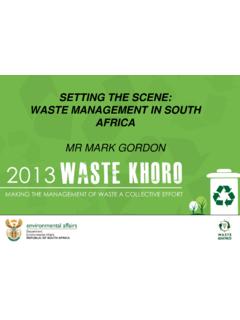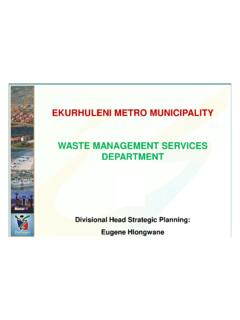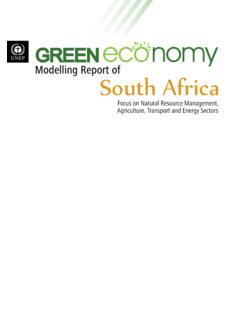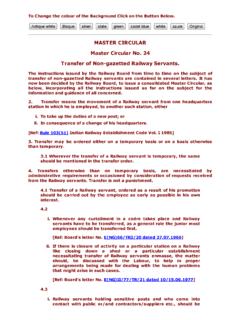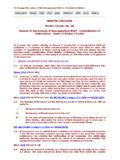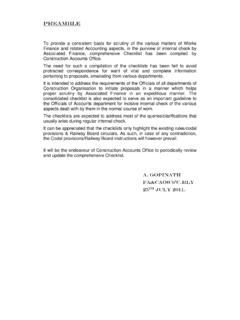Transcription of National Environmental Management: Air Quality …
1 / STAATSKOERANT, 31 MAART 2010 3 GOVERNMENT NOTICE DEPARTMENT OF Environmental AFFAIRS No. 248 31 March 201 o National Environmental management : AIR Quality ACT, 2004 (ACT NO. 39 OF 2004) LIST OF ACTIVITIES WHICH RESULT IN ATMOSPHERIC EMISSIONS WHICH HAVE OR MAY HAVE A SIGNIFICANT DETRIMENTAL EFFECT ON THE ENVIRONMENT, INCLUDING HEALTH, SOCIAL CONDITIONS, ECONOMIC CONDITIONS, ECOLOGICAL CONDITIONS OR CUL TUAAL HEAIT AGE !, Buyefwa Patience Sonjica, Minister of Water and Environmental Affairs, hereby establishes the list of activities as contemplated in Section 21 (1 ){a) of the National Environmental management : Air Quality Act, 2004 (Act No. 39 of 2004) and the minimum emission standards for these llsted activities as contemplated in Section 21 (3)(a) and (b) of the Act as set out in the Schedule hereto. In terms of Section 21 (3)(c) of the Act, 1 April 2010 is the date on which this Notice takes effect. -'\-~,) <--~iJC~ BUY LWA SONJICA, MP MINI TER OF WATER AND Environmental AFFAIRS OAT : 2010~03~09 4 GOVERNMENT GAZETTE, 31 MARCH 2010 USTED ACI1 VITIES AND ASSOCIATED MINIMUM EMISSION STANDARDS IDENTIFIED IN TERMS OF SECI10N 21 OF THE National Environmental management : AIR Quality ACI', 2004 (ACI' NO.}
2 39 OF 2004) SCHEDULE TABLE OF CONTENTS Part 1: Definitions .. 6 1. Definitions .. 6 Part 2: General .. 8 2. Applicability of the Notice .. 8 3. Averaging Period .. 8 4. Emission measurement .. 8 5. CompliAnce time frnmes .. 8 6. Postponement of compliance time frames .. 9 7. Compliance monitoring .. 9 8. Reporting Requirements .. 10 9. General special arrangement .. 11 Part 3: Minimum Emission Standards .. 11 10. Category 1: Combustion InstaUations .. 11 (1) Subcategory : Solid fuel combustion installations .. 11 (2) Subcategory : Liquid f'.rel combustion installations .. 12 (3) Subcategory : Solid biomass combustion installations .. 12 (4) Subcategory : Gas combustion installations .. 12 11. Category 2: Petroleum Industry, the production of gaseous and liquid fuels as weD as petrochemicals from crude oil, coal, gas or biomass .. 13 (1) Subcategory : Combustion installations .. 13 (2) Subcategory : Storage and Handling of Petroleum Products .. 13 (3) Subcategory : Industrial fuel oil recyclers.
3 14 12. Category 3: Carbonization and Coal Gasification .. 15 ( 1) Subcategory : Combustion installations .. 15 (2) Subcategory : Coke production and coal gasification .. 15 (3) Subcategory : Tar Production.. 16 (4) Subcategory Char, charcoal and carbon blackproduction .. 16 (5) Subcategory Electrode paste production .. 17 / STAATSKOERANT, 31 MAART 2010 5 USTED ACTIVITIES AND ASSOCIATED MINIMUM EMISSION STANDARDS IDENTIFIED IN TERMS OF SECTION 21 OF THE National Environmental management : AIR Quality ACT, 2004 (ACT NO. 39 OF 2004) 13. Category 4: MetaUurgicaJ Industry .. 17 (1) : Drying .. 17 (2) Subcategory : Combustion installations .. 17 (3) Subcategory : Primary aluminium production .. 17 (4) Subcategory : Secondary aluminium production .. 18 (5) Subcategory : Sinter plants .. 18 (6) Subcategory : Basic oxygen furnace steel making .. 18 (7) Subcategory 4. 7: Electric arc furnace and steel making (primary and secondary) .. 19 (8) Subcategory : Blast furnace operations.
4 19 (9) Subcategory : Ferro-alloy production .. 19 (10) Subcategory : Foundries .. 20 ( 11) Subcategory : Agglomeration operations .. 20 (12) Subcategory : Pre-reduction and direct reduction .. 20 (13) Subcategory : Lead smelting .. 20 (14) Subcategory : Production and processing of zinc, nickel and cadmium .. 21 (15) Subcategory : Processing of arsenic, antimony, beryllium chromium and silicon .. 21 ( 16) Subcategory : Smelting and converting of sulphide ores .. 21 (17) Subcategory : Precious and base metal production and refining .. 22 (18) Subcategory : Vanadium ore processing .. 22 (19) Subcategory : Production and casting of bronze and brass, and casting copper .. 23 (20) Subcategory : Slag processes .. 23 (21) Subcategory : Metal recovery .. 23 (22) Subcategory : Hot dip galvanizing .. 24 (23) Subcategory : Metal Spray .. 24 14. Category 5: Mineral Processing, Storage and Handling .. 24 (1) Subcategory : Storage and handling of ore and coa/.. 24 (2) Subcategory : Clamp kilns for brick production.
5 25 (3) Subcategory : Cement production (using conventional fuels and raw materials) .. 25 (4) Subcategory : Cement production (using alternative fuels and/or resources) .. 25 (5) Subcategory : Lime production .. 26 (6) Subcategory : Glass and mineral wool production .. 26 (7) Subcategory : Ceramic production .. 27 (8) Subcategory : Macadam preparation .. 27 (9) Subcategory : Alkali processes .. 27 15. Category 6: Organic Chemicals Industry .. 28 ( 1) Subcategory : Organic chemical manufacturing .. 28 6 GOVERNMENT GAZETTE, 31 MARCH 2010 LISI'ED ACTIVITIES AND ASSOCIATED MINIMUM EMISSION STANDARDS IDENTIFIED IN TERMS OF SECTION 21 OF THE National Environmental management : AIR Quality ACf, 2004 (ACf NO. 39 OF 2004) 16. Category 7: Inorganic Chemicals Industry .. 29 (1) Subcategory : Primary production and use in manufacturing of ammonia, fluorine, chlorine, and Hyd7togen Cyanide .. 29 (2) Subcategory : Primary production of acids .. 29 (3) Subcategory : Primary production of chemical fertilizer.
6 30 (4) Subcategory : Manufacturing activity involving the production, use in manufacturing or recovery of antimony, arsenic, beryllium, cadmium, chromium, cobalt, lead, mercury, selenium, by the application of heat .. 30 (5) Subcategory : Production of calcium carbide .. 30 (6) Subcategory : Production of phosphorus and phosphate salts not mentioned elsewhere .. 30 17. Category 8: Disposal of hazardous and general waste.. 31 18. Category 9: Pulp and Paper Manufacturing Activities, including By-Products Recovery .. 31 (1) Subcategory : Lime recovery kiln .. 31 (2) Subcategory : Alkali waste chemical recovery furnaces .. 32 (3) Subcategory : Copeland alkali waste chemical recovery process .. 32 (4) Subcategory : Chlorine dioxide plant .. 32 (5) Subcategory : Wood drying and the production of manufactured wood products .. 32 19. Category 10: Animal matter processing .. 33 SCHEDULE A-METHODS FOR SAMPLING AND ANALYSIS .. 33 Part ]:Definitions 1. Definitions (1) In this Notice a word or expression to which a meaning has been assigned in the Act has that meaning and, unless the context otherwise indicates: -"Act" means the National Environmental management : Air Quality Act 2004 (Act of 2004).
7 "Alternative fuels and resources" means general and hazardous waste materials or secondary products from other industries which are used to substitute conventional or primary fossil fuel and/or virgin raw materials in cement kilns and other industrial processes. "Atmospheric Emission License'' means an atmospheric emission license contemplated in Chapter 5 of the Act. "Biomass" means non-fossilised and biodegradable organic material originating from plants, animals and micro-organisms excluding (a) sewage; and (b) treated or coated wood waste which may contain halogenated organic compounds or heavy metals. "Design capacity" means capacity as installed. "Existing Plant" shall mean any plant or process that was legally authorized to operate before the date on which this Notice takes effect or any plant where an application for authorisation in / STAATSKOERANT, 31 MAART 2010 7 USTED AC-"TTVVTIES AND ASSOCIATED MINIMUM EMISSION STANDARDS IDENTIFIED IN TERMS OF SECTION 21 OF THE National Environmental management : AIR QUAUTY ACf, 2004 (ACf NO.)
8 39 OF 2004) terms of the National Environmental management Act 1998 (Act of 1998), as amended, was made before the date on which this Notice takes effect. "Flare" means a combustion device that uses an open flame to burn combustible gases with combustion air provided by ambient air around the flame. Combustion may be steam or air assisted. Flares may be either continuous or intermittent. This term includes both ground and elevated flares. "Fugitive emissions" means emissions to the air from a facility for which an emission licence has been issued, other than those emitted from a point source. "Licensing authority" means an authority referred to in sections 36(1), (2), (3) or (4) responsible for implementing the licensing system set out in Chapter 5 of the Act. "Listed activities" includes the singular. "New Plant" shall mean any plant or process where the application for authorisation in terms of the National Environmental management Act 1998 (Act of 1998), as amended, was made on or after the date on which this Notice takes effect.
9 "Normal operating condition" means: .:my that operation as designed. "Oxides of nitrogen (NOx)" means the sum of nitrogen oxide (NO) and nitrogen dioxide (N02) expressed as nitrogen dioxide (N02) "Particulate Matter (PM)" means total particulate matter, that is the solid matter contained in the gas stream in the solid state as well as the insoluble and soluble solid matter contained in entrained droplets in the gas stream, as measured by the appropriate method listed in section 4. "Petrochemicals" means ethylene and its polymers, ethylene oxide, ethylene glycol, glycol ethers, ethoxylates, vinyl acetate, 1,2-dichloroethane, trichloroethylene, tetrachloroethylene, vinyl chloride, propylene, propyl alcohols, acrylonitrile, propylene oxide, isomers of butylene, butyl ethers, butadienes, polyolefins and alpha-olefins, all alcohols (except those produced during the production of beverages), acrylic acid, allyl chloride, epichlorohydrin, benzene and alkylbenzenes, toluene, o-, m-and p-xylene, ethylbenzene, styrene, cumene, phenols, acetone, cyclohexane, adipic acid, nitrobenzene, chlorobenzene, aniline, methylene diphenyl diisocyanate (MDI), toluene di-isocyanate or other di-isocynates of comparable volatility, benzoic acid.
10 "Point source" means a single identifiable source and fixed location of atmospheric emission, and includes smoke stacks and residential chimneys. "SANAS" means the South African National Accreditation System established by Section 3 of the Accreditation for Conformity Assessment Calibration and Good Laboratory Practice, 2006 (Act No. 19 of2006). "Sulphur Recovery Plant" means a process unit that processes sulphur containing gases obtained from the processing of crude mineral oil or the coking or gasification of coal and produces a final product of elemental sulphur. "Upset conditions" means any temporary failure of air pollution control equipment or process equipment or failure of a process to operate in a normal or usual manner that leads to an emission standard being exceeded. "Total Volatile Organic Compounds" means any compound of carbon, excluding carbon monoxide, carbon dioxide, carbonic acid, metallic carbides or carbonates, and ammonium carbonate, which participates in atmospheric photochemical reactions.


